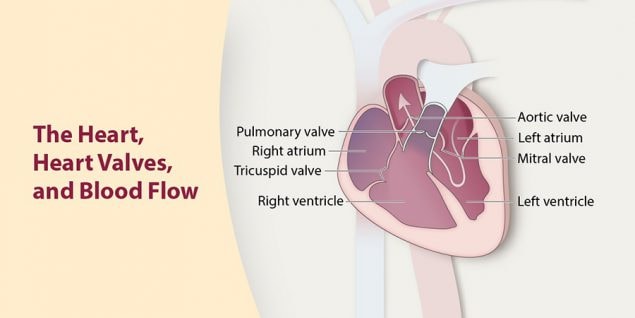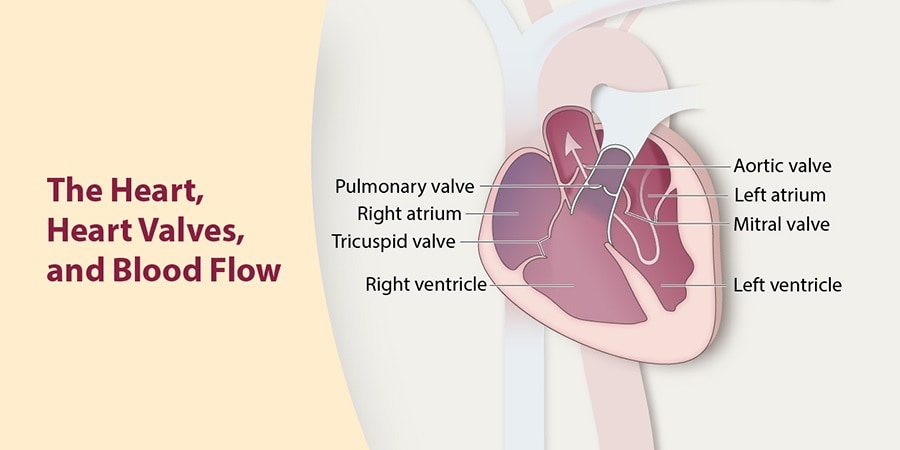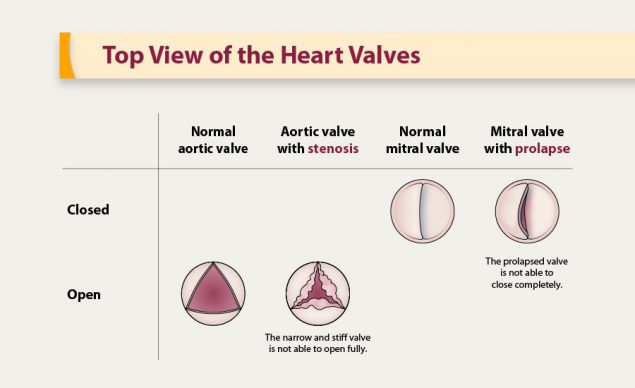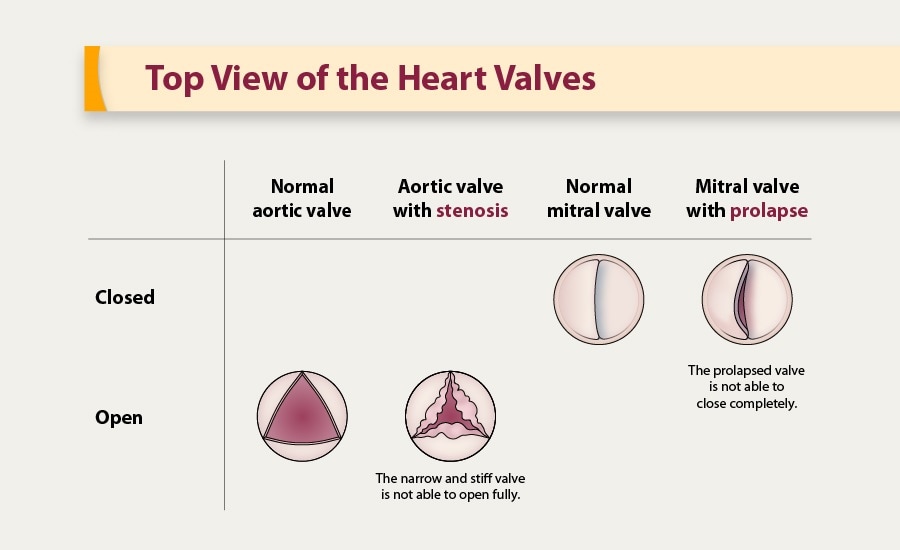Valvular Heart Disease
What is valvular heart disease?
Valvular heart disease is when any valve in the heart has damage or is diseased. There are several causes of valve disease.
- The normal heart has four chambers (right and left atria, and right and left ventricles) and four valves (Figure 1).
- The mitral valve, also called the bicuspid valve, allows blood to flow from the left atrium to the left ventricle.
- The tricuspid valve allows blood to flow from the right atrium to the right ventricle.
- The aortic valve allows blood to flow from the left ventricle to the aorta.
- The pulmonary valve allows blood to flow from the right ventricle to the pulmonary artery.
The valves open and close to control or regulate the blood flowing into the heart and then away from the heart. Three of the heart valves are composed of three leaflets or flaps that work together to open and close to allow blood to flow across the opening. The mitral valve only has two leaflets (Figure 2).
Healthy heart valve leaflets are able to fully open and close the valve during the heartbeat, but diseased valves might not fully open and close. Any valve in the heart can become diseased, but the aortic valve is most commonly affected.
Diseased valves can become “leaky” where they don’t completely close; this is called regurgitation. If this happens, blood leaks back into the chamber that it came from and not enough blood can be pushed forward through the heart.
The other common type of heart valve condition happens when the opening of the valve is narrowed and stiff and the valve is not able to open fully when blood is trying to pass through; this is called stenosis (Figure 2).
Sometimes the valve may be missing a leaflet—this more commonly involves the aortic valve. If the heart valves are diseased, the heart can’t effectively pump blood throughout the body and has to work harder to pump, either while the blood is leaking back into the chamber or against a narrowed opening. This can lead to heart failure, sudden cardiac arrest (when the heart stops beating), and death.
Facts About Valvular Heart Disease
- About 2.5% of the U.S. population has valvular heart disease, but it is more common in older adults. About 13% of people born before 1943 have valvular heart disease.1
- Rheumatic heart disease most commonly affects the mitral valve (which has only two leaflets; Figure 2) or the aortic valve, but any valve can be affected, and more than one can be involved.
- Bicuspid aortic valve (having only two leaflets rather than the normal three) happens in about 1% to 2% of the population and is more common among men.
- In 2017, there were 3,046 deaths due to rheumatic valvular heart disease and 24,811 deaths due to non-rheumatic valvular heart disease in the United States.2
- Nearly 25,000 deaths in the U.S. each year are due to heart valve disease from causes other than rheumatic disease.2
- Valvular heart disease deaths are more commonly due to aortic valve disease (Figure 3)
What causes valvular heart disease?
There are several causes of valvular heart disease, including congenital conditions (being born with it), infections, degenerative conditions (wearing out with age), and conditions linked to other types of heart disease.
- Rheumatic disease can happen after an infection from the bacteria that causes strep throat is not treated with antibiotics. The infection can cause scarring of the heart valve. This is the most common cause of valve disease worldwide, but it is much less common in the United States, where most strep infections are treated early with antibiotics. It is, however, more common in the United States among people born before 1943.
- Endocarditis is an infection of the inner lining of the heart caused by a severe infection in the blood. The infection can settle on the heart valves and damage the leaflets. Intravenous drug use can also lead to endocarditis and cause heart valve disease.
- Congenital heart valve disease is malformations of the heart valves, such as missing one of its leaflets. The most commonly affected valve with a congenital defect is a bicuspid aortic valve, which has only two leaflets rather than three.
- Other types of heart disease:
- Heart failure. Heart failure happens when the heart cannot pump enough blood and oxygen to support other organs in your body.
- Atherosclerosis of the aorta where it attaches to the heart. Atherosclerosis refers to a buildup of plaque on the inside of the blood vessel. Plaque is made up of fat, calcium, and cholesterol.
- Thoracic aortic aneurysm, a bulge or ballooning where the aorta attaches to the heart.
- High blood pressure.
- A heart attack (also known as myocardial infarction or MI), which can damage the muscles that control the opening and closing of the valve.
- Other:
- Autoimmune disease, such as lupus.
- Marfan syndrome, a disease of connective tissue that can affect heart valves.
- Exposure to high-dose radiation, which may lead to calcium deposits on the valve.
- The aging process, which can cause calcium deposits to develop on the heart valves, making them stiff or thickened and less efficient with age.
What are the symptoms of valvular heart disease?
Heart valve disease can develop quickly or over a long period. When valve disease develops more slowly, there may be no symptoms until the condition is quite advanced. When it develops more suddenly, people may experience the following symptoms:
- Shortness of breath
- Chest pain
- Fatigue
- Dizziness or fainting
- Fever
- Rapid weight gain
- Irregular heartbeat
How is valvular heart disease diagnosed?
The doctor may hear a heart murmur (an unusual sound) when listening to your heartbeat. Depending on the location of the murmur, how it sounds, and its rhythm, the doctor may be able to determine which valve is affected and what type of problem it is (regurgitation or stenosis).
A doctor may also use an echocardiography, a test that uses sound waves to create a movie of the valves to see if they are working correctly.
How is valvular heart disease treated?
If the condition isn’t too severe, it might be managed with medicines to treat the symptoms. If the valve is more seriously diseased and causing more severe symptoms, surgery may be recommended. The type of surgery will depend on the valve involved and the cause of the disease. For some conditions, the valve will need to be replaced by either opening the heart during surgery or replacing the valve without having to open the heart during surgery.
References
- Otto CM, Bonow RO. Valvular Heart Disease: A Companion to Braunwald’s Heart Disease. 4th ed. Philadelphia, PA: Elsevier Saunders; 2014.
- Centers for Disease Control and Prevention, National Center for Health Statistics. Underlying Cause of Death 1999-2017 on CDC WONDER Online Database, released December, 2018. Data are from the Multiple Cause of Death Files, 1999-2017, as compiled from data provided by the 57 vital statistics jurisdictions through the Vital Statistics Cooperative Program. Accessed at http://wonder.cdc.gov/ucd-icd10.html on Oct 24, 2019.




